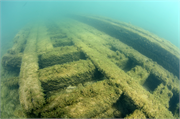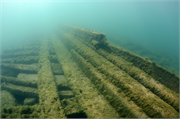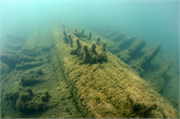0.45 miles E of Whistling Straights Golf Course, in Lake Michigan
| Historic Name: | Montgomery Shipwreck (schooner) |
|---|---|
| Reference Number: | 100004377 |
| Location (Address): | 0.45 miles E of Whistling Straights Golf Course, in Lake Michigan |
|---|---|
| County: | Sheboygan |
| City/Village: | |
| Township: | Mosel |
| Montgomery Shipwreck (schooner) 0.45 miles E of Whistling Straights Golf Course, in Lake Michigan, Mosel, Sheboygan County Builder: John Oades Date of Construction: 1853 On a rocky bottom 0.45 miles east of the Whistling Straights Golf Course, in the town of Mosel, Sheboygan County, Wisconsin, the double centerboard schooner Montgomery lies in 12 feet of water on the bottom of Lake Michigan. The vessel’s keelson and floors remain intact on the site along with its centerboard trunks, and hull planking. The vessel was launched as the canal schooner Northern Light, from the shipyard of John Oades in Clayton, New York in 1853. Built for merchants John N. Fowler and Henry Esselstyn of the firm Fowler & Esselstyn of Clayton, New York, the Northern Light primarily operated in the grain and lumber industries. In 1866, the vessel was relaunched with a second centerboard, as the canal schooner Montgomery, and operated in the region for another 24 years. On 5 November 1890, Montgomery came ashore during a gale while en route to Sheboygan with a cargo of coal. The vessel grounded grounding in eleven feet of water eight miles north of the city near Stoney Creek and immediately began to fill with water. Although relatively close to shore, the nearby lifesaving station did not see the stranded vessel, however, no lives were lost. The vessel was stripped and its cargo salvaged shortly after the sinking. The location of the Montgomery site was forgotten until 1958 when skin divers, who were stationed at Camp Haven located the wreckage and dove it in their spare time. The site became popular with divers in the 1970s, but the exact location of the site was lost in the intervening years. The site was brought to the attention of the Wisconsin Historical Society in June of 2015 by Steve Radovan, but the site was not located until 2018. Maritime Archaeologists and volunteers from the Society documented the site in June of 2018. Although severely broken, Montgomery site has already produced archaeological knowledge about double centerboard schooners, and has the potential to yield a vast amount of knowledge about double centerboard schooner construction and the lumber, grain, and coal industries State and federal laws protect this shipwreck. Divers may not remove artifacts or structure when visiting this site. Removing, defacing, displacing, or destroying artifacts or sites is a crime. More information on Wisconsin’s historic shipwrecks may be found by visiting Wisconsin’s Great Lakes Shipwrecks website. |
| Period of Significance: | 1866-1890 |
|---|---|
| Area of Significance: | Archeology/Historic - Non-Aboriginal |
| Area of Significance: | Maritime History |
| Area of Significance: | Commerce |
| Applicable Criteria: | Information Potential |
| Historic Use: | Transportation: Water-Related |
| Architectural Style: | Other |
| Resource Type: | Site |
| Architect: | Johns Oades |
| Architect: | Simon G. Johnston |
| Historic Status: | Listed in the State Register |
|---|---|
| Historic Status: | Listed in the National Register |
| National Register Listing Date: | 09/13/2019 |
| State Register Listing Date: | 05/17/2019 |
| Number of Contributing Buildings: | 0 |
|---|---|
| Number of Contributing Sites: | 1 |
| Number of Contributing Structures: | 0 |
| Number of Contributing Objects: | 0 |
| Number of Non-Contributing Buildings: | 0 |
| Number of Non-Contributing Sites: | 0 |
| Number of Non-Contributing Structures: | 0 |
| Number of Non-Contributing Objects: | 0 |
| National Register and State Register of Historic Places, State Historic Preservation Office, Wisconsin Historical Society, Madison, Wisconsin |



